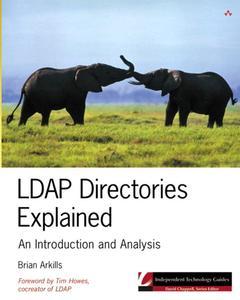LDAP directories explained : an introduction and analysis
Langue : Anglais
Auteur : ARKILLS Brian

Directory technology promises to solve the problem of decentralized information that has arisen with the explosion of distributed computing. Lightweight Directory Access Protocol (LDAP) is a set of protocols that has become the Internet standard for accessing information directories. Until now, however, those curious about LDAP had no introductory source to learn how the technology can help them centrally manage information and reduce the cost of computing services. LDAP Directories Explained provides technical managers and those new to directory services with a fundamental introduction to LDAP. This concise guide examines how the technology works and gives an overview of the most successful directory products in an easy-to-reference format.
Foreword. Preface. Acknowledgments. Part 1: HOW LDAP WORKS.. 1 Overview of LDAP. Introducing Directories. Structure. Content and Usefulness. Benefits of a Directory. Introducing LDAP. Mycompany.com. Namespace. Protocol. Schema. Management. Vendor LDAP Products. Why Choose LDAP? 2 LDAPNamespace. DNS. DNS Hierarchy. DNS Resolution. Basic DNS Record Types. How LDAP Uses DNS. LDAP Object Structure. Allowed Structures. LDAPContainers. Structure Rules. Naming Contexts. LDAP Object Naming. Relative Distinguished Name (RDN). Naming Attributes. Distinguished Name (DN). Naming Special Characters. URLNaming. LDAP v2 Naming Conventions. Special LDAP Structural Concepts. Summary. 3. Client LDAP Operations. Directory-Enabled Services and Applications. Search. Mandatory Search Parameters. Optional Search Parameters. Search Filters. LDAPProtocol. LDAPOperations. LDAPControls. LDAP Client Options. APIs. Summary. Appendix Material. 4. LDAPSchema. Object Classes. Elements of an Object Class. Creating the Entry You Want. Attributes. Elements of an Attribute Type. Attribute Subtypes. Attribute Options. Operational Attributes. Syntaxes. Matching Rules. OIDs. Schema Checking. Extended Schema Definitions. DNS Extensions. extensibleObject Object Class. dynamicObject Object Class. Java. inetOrgPerson Object Class. Still in Development. Summary. Appendix Material. 5. Directory Management. Replication. Partitions. Replicas. Referrals. Referral Resolution. Referral Syntax. Referral Examples. Chaining. Aliases Distributed Directory. Reliability. Replication Topology. Maintenance. Integrating Independent Directories. Data Architecture Management. Metadirectories: Glue Together Your Directories. Master Directory. Directory Synchronization. Loose Directory Interconnection. Harvesting Data (Connectors). Moving Data Between Directories. LDIF. DSML. Directory Security. Authentication. Authorization. Encryption. Administrative Server Parameters. Other Directory Management Tasks. Summary. Part 2: HOW VENDORS HAVE IMPLEMENTED LDAP.. 6. OpenLDAP. Namespace. Naming Contexts and Partitions. Distributed Directory Functionality. Database Functionality. Indexing. Operations and Clients. Clients. Controls. Schema. Classes. Attributes. Management. Special Configuration Parameters. Security. Authentication. Authorization. Privacy. Why OpenLDAP? 7. Microsoft Active Directory. Namespace. DNS. Directory Namespace. Sites. Naming Contexts and Partitions. Global Catalog. Operations and Clients. Clients. Controls. Directory-Enabled Services. Schema. Classes. Attributes. Management. Replication. Indexing. Data Architecture. Special Configuration Parameters. Security. Authentication. Authorization. Privacy. Why Active Directory? 8. Directory Server. Namespace. Naming Contexts. Database Functionality. Indexing. Referrals. Chaining. Operations and Clients. Clients. Controls. Plug-ins. Schema. Groups. Roles. Class of Service (CoS). Management. Replication. Special Configuration Parameters. Security. Authentication. Authorization. Privacy. Why Directory Server? APPENDIXES. A. Client LDAP Operations Appendix. Draft Controls. PSEARCH. TSEARCH. DIRSYNC. LCUP. Chaining. Virtual List View. C language API. B. Schema Appendix. Schema Formats. ASN.1 Object Class Syntax. ASN.1 Attribute Syntax. BNF Object Class Syntax. BNF Attribute Syntax. Slapd.conf Object Class Syntax. Slapd.conf Attribute Syntax. Common Syntaxes. Common Matching Rules. C. Stanford University Directory Architecture. Environment. Source Systems. Stanford Registry. Privacy Controls. Directory Harvester. Event Database. Stanford Directory. E-mail Service Integration. Web UI Integration. Updating Your Personal Information. Active Directory Harvester. Privacy Control in AD. Summary. D. OpenLDAP Access Control. Element. Element. Element. Evaluation of Access. Comprehensive Example. E. Active Directory Controls Appendix. F. Directory Server Appendix.
Date de parution : 04-2003
Ouvrage de 400 p.
19x23 cm
Thème de LDAP directories explained : an introduction and analysis :
© 2024 LAVOISIER S.A.S.
